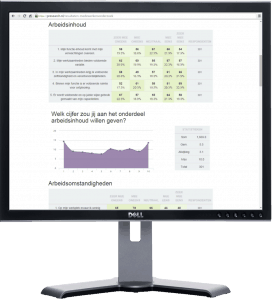Employee survey is a tool to increase employee satisfaction and engagement. About 65 per cent of all organisations in the Netherlands conduct periodic employee surveys. But what is behind such a employee survey? And what is its added value? This article therefore explains what employee survey is and how this tool has evolved in recent decades.
Employee survey definition
Employee survey is a means of involving employees in the organisation's operations (Burke & Cooper, 2006). The survey is usually conducted annually and applied through a digital questionnaire. The content of the employee survey can vary greatly, depending on the organisation and/or research firm. The idea is that employees' output increases when they are valued more. Employee survey is often part of human resources management that supports this line of thinking.
The video below explains how employee survey can be used to retain talent and performers to the organisation.

Development
In the 1970s, satisfaction measurement was initiated by organisations like IBM. The initial focus was to identify problems within the organisation and leadership. From the 1980s there was more focus on the contribution of employees after which in the 21st century involvement of employees has become central. Here, the idea is that involvement of employees leads to a better competitive position. For example, it turns out that organisations with low engagement 50% pay out less to shareholders than the companies that show higher engagement.
Nevertheless, measuring employee satisfaction added value to date. Satisfaction with the organisation is more important than the exact job the employee performs. This reasoning seems quite logical as measuring "organisational satisfaction" says much more about the context in which someone works on a daily basis. The employee is a social animal who wants to be part of a bigger picture and add value in it. When organisational satisfaction is high, it makes sense that employees are also more engaged and the reverse.
"Employee survey remains only one link in achieving the best and most competitive organisation. Ultimately, leaders are needed to actually realise improvement actions."
Application and future
This makes it important to take a critical look at what "needs to be measured" and look much more at what the purpose of the employee survey is. It is interesting to carry out benchmarks, to show which departments are performing well but even more important is to create involvement through relevance. Understanding where there is less engagement provides confirmation but even better is understanding which type of employee is engaged and understanding why this is the case. This is where HR Analytics, making human resource management measurable and predictable, will add value.
Employee survey As a result, within human resources management, it remains only an important link in achieving the best organisation. It is a tool that can be used to promote feedback. Then translating feedback into concrete actions requires leadership from all involved. At organisational, team and individual level.
Burke, R. J., & Cooper, C. L. (Eds.) (2006). The Human Resources Revolution: Why putting people first matters. Bingley, UK: Emerald Group Publishing Limited.
